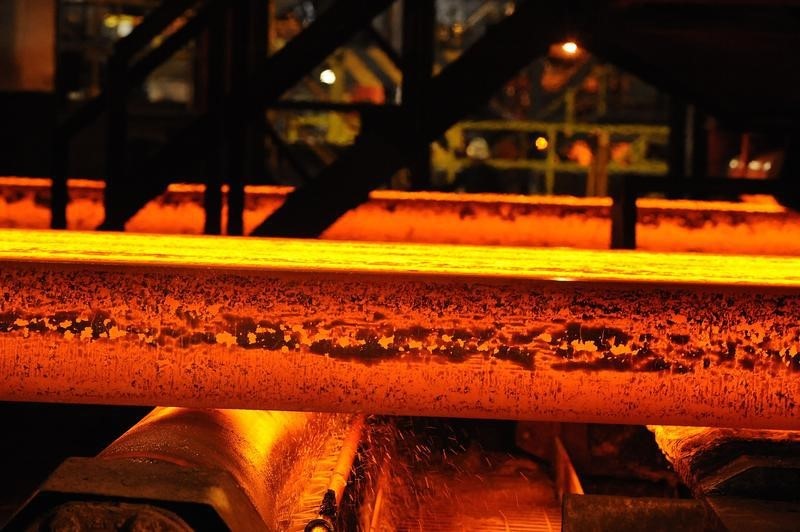
Investing.com — Analysts at Citi Research have updated its outlook for steel prices in 2024, reflecting a nuanced view of both short-term and mid-term dynamics in the steel market.
The analysts take into account various factors affecting supply, demand, pricing, and geopolitical influences. The analysis highlights the persistence of certain secular themes, the impact of tariffs, and evolving market conditions, particularly in the US and China.
1. Short-Term Outlook (1 Year)
Demand trends
In the short term, steel demand is expected to be weaker year-over-year, influenced by several key factors:
-
Construction: The construction sector is forecasted to experience a 5% decline, driven by tighter credit conditions.
-
Automotive: The automotive sector shows modest growth, with an anticipated increase of 1.5 million units in the Seasonally Adjusted Annual Rate (SAAR).
-
General manufacturing: General manufacturing is also projected to weaken by 5%.
Citi’s economic forecasts indicate a potential slowdown in US economic activity, with the possibility of a significant recession. US GDP growth is anticipated to be around 1.1%, and a Federal Reserve rate cut is expected in June.
Despite these challenges, secular themes such as infrastructure investment, energy transition, and supply chain re-shoring are expected to offer some support.
Supply dynamics
The supply side remains complex, with new capacities coming online in various segments, including:
-
Sheet steel: Sinton and BRS2 facilities are ramping up production.
-
Plate steel: NUE KY is increasing output.
-
Rebar: CMC AZ is expanding capacity.
However, the ramp-ups have been slower than expected, possibly due to the complexity of next-generation mills.
Import activity is likely to be influenced by pricing and market strategies, with the BRS2 strategy still to be determined.
Pricing expectations
Steel prices are anticipated to be under pressure in the short term, with hot-rolled coil (HRC) prices projected to range between $650 and $1,100 per ton. Prices are expected to remain under pressure until demand picks up approximately 12 months after the Federal Reserve’s rate cuts.
Wildcards
Several factors could impact the market:
-
US Elections: Political outcomes could influence economic policies and market conditions.
-
China Stimulus: Potential economic stimulus measures in China may affect global steel demand and prices.
-
Global Conflicts: Ongoing conflicts could impact global supply chains and pricing.
2. Mid-Term Outlook (5-10 Years)
Demand drivers
The mid-term outlook remains positive, largely due to:
-
Re-shoring and infrastructure: Long-term demand is supported by trends in re-shoring and infrastructure investments.
-
Economic trends: Despite slower-than-expected infrastructure spending, the overall outlook remains favorable due to ongoing secular trends.
Supply consolidation
The US steel industry has undergone significant consolidation, with mills acquiring assets from foreign owners. This consolidation has enabled more disciplined supply management, with a focus on “value over volume” strategies.
Tariffs and pricing
Tariffs continue to play a crucial role in shaping the market:
-
Import tariffs: US tariffs have effectively set a higher price floor for domestic steel, with a $100 per ton increase in the floor price. In strong demand scenarios, tariffs add approximately 25% to the price.
-
New normal: The average price for steel is expected to remain higher, with $750-$800 per ton now considered the new norm.
Incentive economics
New mill capital expenditure inflation requires higher EBITDA to maintain the same internal rate of return (IRR).
This has led to an adjusted price expectation of around $850 per ton, reflecting increased costs in scrap and transformation.
Consolidation and discipline
The consolidation of US steel producers has led to more disciplined supply management. However, there is evidence that this discipline may be breaking down, with increased competition and capacity ramp-ups.
US-Mexico trade dynamics
Trade issues between the US and Mexico have been a point of contention:
-
Mexican exports: There was a surge in Mexican steel exports to the US, exceeding pre-S232 levels. However, exports have decreased in 2024, with new rules implemented to prevent transshipment.
-
Trade balance: The US remains a net exporter of steel to Mexico, particularly in flat products, while Mexico imports more steel from China.
China’s steel market
China’s steel industry faces significant challenges, with reduced property starts leading to decreased domestic steel consumption.
However, increased infrastructure spending and higher exports have partially offset these declines.
The US steel market remains well-protected compared to previous years, though Chinese steel continues to flow to other major markets.

